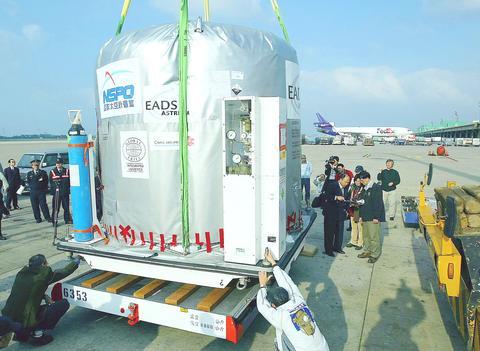Taiwan's second satellite, ROCSAT-2, which left the National Space Program Office (NSPO) in Hsinchu yesterday, is expected to be launch-ed on schedule in six weeks from California.
A trailer with cushion facilities took the 750kg satellite, packaged in a 2,100kg container displaying Taiwan's flag, to CKS International Airport in Taoyuan.

PHOTO: TONY YAO, TAIPEI TIMES
NSPO spokesmen said yesterday that a China Airlines Boeing 747 would carry the satellite and related equipment, weighing 14,295kg, directly to Los Angeles today. After the flight of just more than 10 hours, it will take another six hours to move the satellite by truck to Vandenberg Air Force Base.
"All the way to the base, vibration has to be limited to a certain level," Chern Jeng-shing (
A team of NSPO scientists and engineers arrived at the base yesterday to prepare for the launch on Jan. 17.
Since last Thursday, when the satellite was wrapped, nitrogen has been injected into the container to ensure stable conditions for the long journey.
According to Bobby Yu (余萃眾), general manager of China Airlines' cargo sales and services department, the airline's midway station in Anchorage, Alaska, would be bypassed to minimize the risks.
Richard Shen (沈成), general manager of Global Fritz Logistics Services, said special customs arrangements were made to facilitate the transportation.
When it arrives at Vandenberg Air Force Base, the satellite will be thoroughly tested for three days. The satellite will be coupled with a Taurus rocket, a four-stage, ground-launched vehicle, at a launch site operated by Orbital Sciences Corp, and should be ready at least 13 days prior to the launch.
Taiwan chose to launch the ROCSAT-2 from the US instead of India, which offered a half-price deal.
The launch services in the US cost about NT$ 1.3 billion, according to the NSPO.
Lee Lou-chuang (
"ROCSAT-2 satellite will be the first to observe rare phenomena like lighting-induced red sprites, upwardly discharging blue jets and gigantic jets," Lee said.
Being different from its predecessor, ROCSAT-1, which was launched in January 1999 and had a strictly scientific purpose, ROCSAT-2 will also have more down-to-earth applications involving remote-sensing technologies.
NSPO officials stressed yesterday that the ROCSAT-2 project, costing NT$4.7 billion in total, would further enhance Taiwan's abilities to predict natural disas-ters and map state-owned land. It will be able to take clear pictures of objects on the ground as small as 2m across.
The satellite is designed to orbit the earth 14 times a day, including two passes over Taiwan, 891km above the earth's surface.
Representatives of the Astrium Company of France, the NSPO's main contractor on the ROCSAT-2 project, said yesterday that everything had gone according to plan since the cooperation began in November 1999.

Taiwan is to commence mass production of the Tien Kung (天弓, “Sky Bow”) III, IV and V missiles by the second quarter of this year if the legislature approves the government’s NT$1.25 trillion (US$39.78 billion) special defense budget, an official said yesterday. Commenting on condition of anonymity, a defense official with knowledge of the matter said that the advanced systems are expected to provide crucial capabilities against ballistic and cruise missiles for the proposed “T-Dome,” an advanced, multi-layered air defense network. The Tien Kung III is an air defense missile with a maximum interception altitude of 35km. The Tien Kung IV and V

The disruption of 941 flights in and out of Taiwan due to China’s large-scale military exercises was no accident, but rather the result of a “quasi-blockade” used to simulate creating the air and sea routes needed for an amphibious landing, a military expert said. The disruptions occurred on Tuesday and lasted about 10 hours as China conducted live-fire drills in the Taiwan Strait. The Civil Aviation Administration (CAA) said the exercises affected 857 international flights and 84 domestic flights, affecting more than 100,000 travelers. Su Tzu-yun (蘇紫雲), a research fellow at the government-sponsored Institute for National Defense and Security Research, said the air

Trips for more than 100,000 international and domestic air travelers could be disrupted as China launches a military exercise around Taiwan today, Taiwan’s Civil Aviation Administration (CAA) said yesterday. The exercise could affect nearly 900 flights scheduled to enter the Taipei Flight Information Region (FIR) during the exercise window, it added. A notice issued by the Chinese Civil Aviation Administration showed there would be seven temporary zones around the Taiwan Strait which would be used for live-fire exercises, lasting from 8am to 6pm today. All aircraft are prohibited from entering during exercise, it says. Taipei FIR has 14 international air routes and

Taiwan lacks effective and cost-efficient armaments to intercept rockets, making the planned “T-Dome” interception system necessary, two experts said on Tuesday. The concerns were raised after China’s military fired two waves of rockets during live-fire drills around Taiwan on Tuesday, part of two-day exercises code-named “Justice Mission 2025.” The first wave involved 17 rockets launched at 9am from Pingtan in China’s Fujian Province, according to Lieutenant General Hsieh Jih-sheng (謝日升) of the Office of the Deputy Chief of the General Staff for Intelligence at the Ministry of National Defense. Those rockets landed 70 nautical miles (129.6km) northeast of Keelung without flying over Taiwan,